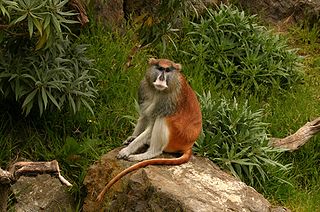
Erythrocebus is a genus of Old World monkey. All three species in this genus are found in Africa, and are known as patas monkeys. While previously considered a monotypic genus containing just E. patas, a 2017 review argued that, based on morphological evidence and heavy geographic separation between taxa, E. patas should be split back into distinct species as recognised in the 19th century.

The common patas monkey, also known as the wadi monkey or hussar monkey, is a ground-dwelling monkey distributed over semi-arid areas of West Africa, and into East Africa.

Cyber Team in Akihabara is a 1998 Japanese anime television series created by Tsukasa Kotobuki and Satoru Akahori. It aired from April 4, 1998 to September 26, 1998 on TBS and ran for 26 episodes. It was released in the United States by ADV Films and was also broadcast on international networks such as Anime Network, AXN Asia, Locomotion. A 1-hour featured animation film of the series was subsequently released in Japan entitled Cyber Team in Akihabara: Summer Vacation of 2011; unlike the series the film was produced by Production I.G and Xebec. The show has an array of characters, many of whom are named after birds, gods, and real-myth villains.

Pantheinae is a small subfamily of moth family Noctuidae. It used to be considered a family, under the name Pantheidae.
Craugastor charadra is a species of frogs in the family Craugastoridae.
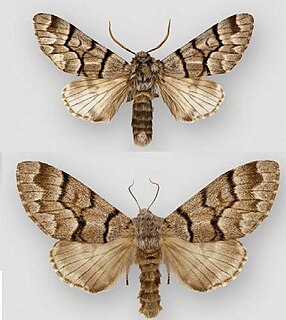
Panthea guatemala is a moth of the family Noctuidae. It has been collected in the mountains of Guatemala and the states of Oaxaca and Chiapas in adjacent southern Mexico at elevations of 1580–1850 m.

Charadra is a genus of moths of the family Noctuidae.

Charadra deridens is a moth of the family Noctuidae. It is found in Ontario, Quebec, New Brunswick, Nova Scotia, Prince Edward Island, British Columbia, Saskatchewan and Manitoba in Canada, through most of the United States except the south-western states.
Psectrotarsia rhodophora is a species of moth of the family Noctuidae. It is only known from Guatemala.

Charadra patafex is a moth of the family Noctuidae. It is known only from Guerrero Mill in the State of Hidalgo in Mexico, where it was found at 9000 feet elevation.
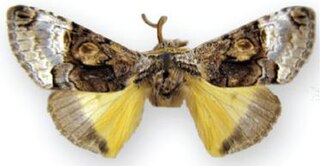
Charadra oligarchia is a moth of the family Noctuidae. It is known only from Guerrero Mill in the State of Hidalgo in Mexico, where it was found at 9000 feet elevation.

Charadra franclemonti is a moth of the family Noctuidae. It is found from central Arizona southward to at least Durango in Mexico.
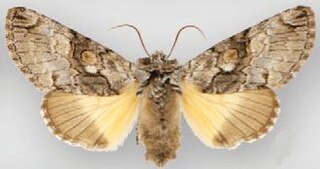
Charadra tapa is a moth of the family Noctuidae. It is found in the Chiricahua, Huachuca, and Santa Rita Mountains of south-eastern Arizona, although the species probably occurs in adjacent parts of Mexico.

Charadra cakulha is a moth of the family Noctuidae. It is known only from two specimens of the type series, collected in mid-June at San Cristobal de las Casas, Chiapas, Mexico.

Charadra coyopa is a moth of the family Noctuidae. It is known only from the holotype specimen from the Mexico City area.
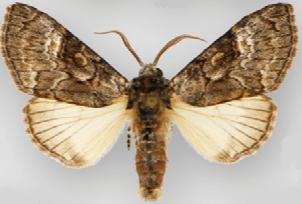
Charadra moneta is a moth of the family Noctuidae. It is found from central and eastern Arizona, the San Mateo Mountains of New Mexico, the Guadalupe Mountains of New Mexico and Texas, and the Big Bend region of Texas; south to the Sierra Madre in Nuevo León, northern Mexico.

Charadra dispulsa is a moth of the family Noctuidae. Its range spans from Texas southward and westward to at least San Luis Potosí, Mexico.
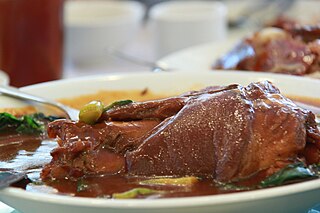
Pata tim, also spelled patatim, is a Filipino braised pork hock dish slow-cooked until very tender in soy sauce, black peppercorns, garlic, bay leaves, and star anise sweetened with muscovado sugar. It also commonly includes péchay and mushrooms. The dish is commonly served in regions in the Philippines with large Chinese Filipino populations, especially in the Binondo district of Manila.
This page is based on this
Wikipedia article Text is available under the
CC BY-SA 4.0 license; additional terms may apply.
Images, videos and audio are available under their respective licenses.












